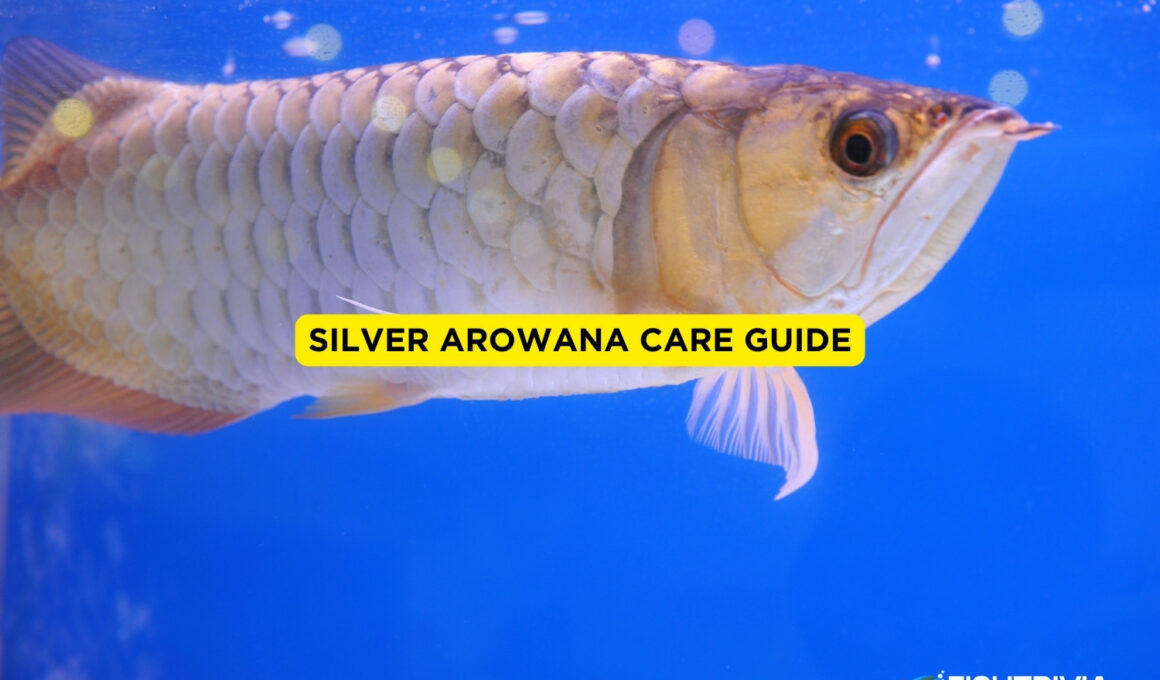In this article Show
Silver Arowana type of fish is a big and stunning freshwater fish with an outstanding reputation in the aquatic world.
Unfortunately, most aquarists get frightened by this species, whereas others see ownership of such species as a difficult and gratifying move in their fishkeeping growth. However, if you fall into this category, there is a need for you to change and try investing in Silver Arowana fish species.
Although not usually advised for newbies, this species can provide a superb addition to a skilled tank keeper. This article will discuss the basics of the Silver Arowana species on care and everything else you need to know.
It not only prepares you for ownership of the species but also helps you better understand what one of these enormous fish looks like.
Also worth reading;
- Asian Arowana Care Guide: Habitat, Tank Size, Breeding
- Why Are Asian Arowana Illegal? What You Should Know
- Are Arowana Fish Aggressive? All You Need to Know
- 19 Best Arowana Tank Mates
A Summary Of The Silver Arowana Species
The biological name for the Silver Arowana is Osteoglossum bicirrhosum. It is one of the most valued fishes by many aquarists, and it’s mostly considered the apex of recreational fish. These species are said to have originated from America’s Amazon River Basin.
Silver Arowana species are respected for their appearance and predatory activity. Additionally, they are highly aggressive and require some high care needs. However, they are not, by any means, a nice fish for beginners. To maintain the Silver Arowana species healthy, ensure you provide them with a strongly controlled environment and lots of high-quality nutrients.
The Appearance Of Silver Arowana
They belong to a rare kind of fish known as “band fishes.” The Silver Arowana have long and slim bodies. While their bodies taper in the direction of the tailfin, it is not almost as spectacular as those other species. Consequently, they adopt a band-like form.
Silver Arowana looks rather flat from its side, but one will note that they have a significant girth when looked at from their front-on. Silver Arowanas’ greatest identifying trait is its fins. Both the anal and dorsal fins run up to the remarkably short tailfin.
Silver Arowanas’ greatest identifying trait is its fins. Both the anal and dorsal fins run up to the remarkably short tailfin. Since these fins cover most of the Silver Arowana’s body, most people don’t even know that its tailfin is usually smaller than could be expected on such a large fish.
Actually, at first sight, it seems to be connected to the species’ body, but only after closer scrutiny can you notice a gap between the tailfin and the others.
Their pectoral and pelvic fins are usually small and have two separate barbells on their heads. The barbells are located at the tip of the species’ mouth, hence giving the Silver Arowana a ‘dragon look,’ as its nickname (Dragonfish) suggests.
The mouth line of this species is another significant aspect that is vertical and works like a drawbridge. The unusual structure enables the Silver Arowana to sneak fast and effectively on the prey.
As the species name suggests, these fish are silver in color, with large scales covering their whole body. The scales give the fish a slightly glittery look and have a somewhat blue tone.
Both female and male Silver Arowanas appear surprisingly similar though a few minor characteristics distinguish them. For example, the male Silver Arowanas appear to have a lengthier anal fin. On the other hand, the female ones tend to be a bit plumber compared to the male species.
Silver Arowana’s Size
As mentioned earlier, the Silver Arowana is a massive fish and can grow up to 3 feet long. This is the typical size for any full-grown Silver Arowana fish species.
A young Silver Arowana is usually very small, around three inches, but it remarkably grows fast with time.
However, the Silver Arowana n grow even longer than this while in the wild. There have been recordings of different specimens growing up to 4 feet long. It is important to note that the Silver Arowana has a fast growth rate and hence should be provided with a large enough aquarium for its comfortability.
General Silver Arowana’s Behavior
Large Silver Arowanas can be surprisingly timid. In most cases, they will be terrified of unexpected emotions; for instance, a rapid turn-on of the lights in the aquarium will frighten this species.
Therefore, it is essential to ensure that the aquarium is placed in a low foot traffic place to reduce the chances of frightening the Silver Arowana.
In most cases, the Silver Arowana swims near the water’s surface while in the aquarium, and it’s interesting to watch them swim this way. However, these species are renowned jumpers and can jump to a height of three meters.
The Silver Arowana jumps, especially when introduced in a new aquarium or when the aquarium is too small. In the case of a reduced aquarium, the Silver Arowana repeatedly tries to jump to free itself from the small tank.
Repeated jumping can cause injuries to the Silver Arowana, especially when the aquarium is covered. Therefore, you must place the Silver in a large and suitable aquarium for its comfort.
Silver Arowana’s Habitat
As mentioned above, the Silver Arowanas are usually big and good swimmers. They have a fast growth rate and may end up outgrowing most hobby aquarium tanks.
The Silver Arowana thus requires a tank with a capacity of at least 250 gallons, hence reducing the chances of jumping.
Young Silver Arowanas (juveniles) can be brought up in a smaller 60-gallon tank, but they will eventually need to be transferred to a larger tank after some time. If this species is not transferred into a larger tank, the Silver Arowana in the aquarium will experience problems such as physical body deformation and decreased life span.
The substratum should include fine and tiny gravel. The aquarium should be established sparsely and have plenty of room for the fish to roam about. You can use rockwork and robust plants to enhance your aquarium. Ensure that you avoid weakly rooted plants in the aquarium since Silver Arowanas can uproot them.
Finally, it is crucial to have the aquarium or, rather, the tank covered with a strong lid to prevent the Silver Arowana from jumping out from the tank, as we have seen that they are notorious jumpers.
How To Care For Silver Arowana
Caring for the Silver Arowana is not usually a simple task as many individuals might think.
Their large sizes and attitude make it challenging to raise hobby tanks. Additionally, these fish might be highly susceptible to low water quality.
The best way to maintain the health of the Silver Arowana fish species is to replicate their native surroundings and monitor environmental conditions. As long as you remain in a moderate set of parameters, you will be careful to bring this fish species to the desired look.
Size Of The Tank
A fully grown Silver Arowana fish should be introduced in the well-spaced tank, with the lowest possible 250 gallons. As we said previously, these fish need quite huge tanks to remain healthy in their entire lifetime.
The young Arowanas can survive in 60-gallon tanks, although they will need to be transferred to larger tanks with time.
The juveniles usually have a very high growth rate, in that in one month, they can grow up to two inches. Therefore, it is advisable to start the juveniles in spacious tanks that can support the excellent growth of the young Arowanas.
If the Silver Arowana does not have an ideal tank size, there may be several concerns. First, the fish can begin to feel cramped, cloudy, anxious, and aggressive. Second, the Arowana could even start jumping out of the aquarium as it is not comfortable in the tank.
They can encounter psychological problems in the worst-case situation. For example, a shortage of room might lead to deformations, ultimately reducing their lifespan.
How To Feed The Silver Arowana
These fish species are predominantly carnivores and require protein-rich nutrients to grow properly. How to feed the Silver Arowana.
Feeding Silver Arowanas is relatively simple. These fish are mostly fleshy, and while they can eat some things from plants, they need protein to flourish.
In the wild, the Silver Arowanas consume smaller species, big insects, and shellfish. The fish can also be provided with nutritious frozen and raw food in captivity. You can also supply the Silver Arowana with earthworms, bloodworms, and any other protein snacks.
How To Breed Arowana Fish
Silver Arowana breeding is relatively rare. The majority of the species that are commonly available at the shops are from commercial fishing.
It’s rare to get a mated pair as they can make things more difficult because the fish often can’t get along together. It is, however, intriguing to watch the two fish mate.
When the fish makes a nest, the female puts her eggs, and once they have all the eggs, the male scoops them into its mouth.
The male keeps the eggs in its mouth for around fifty days till they hatch. The fry then remains for another few weeks. At this moment, the fry is enormous and can even feed on smaller fish.
Conclusion
We have gone through various concepts of what is needed to have a home aquarium for the Silver Arowana species. Only highly skilled aquarists should take up this challenge because of its massive size and long life span. It demands a huge tank, and it can be challenging to find acceptable tank mates for them.
In conclusion, I strongly advise you to take a chance if you have the room, time, and resources to assist these species to grow. It is immensely satisfying to own enormous and tough freshwater species, as we have seen with the Silver Arowana.
For more information about Silver Arowana, Watch this video below;










